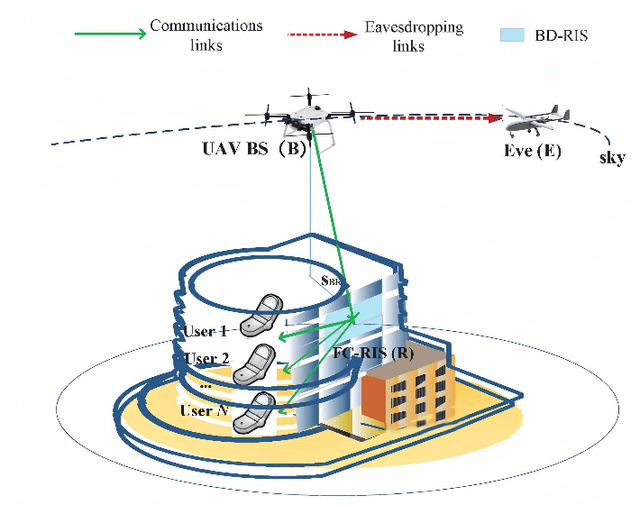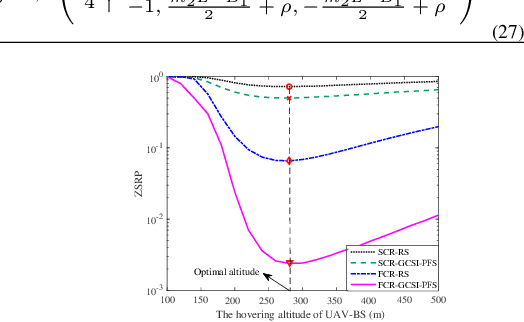Le-Nam Tran
Variational Bayesian Channel Estimation and Data Detection for Cell-Free Massive MIMO with Low-Resolution Quantized Fronthaul Links
Jun 23, 2025Abstract:We study the joint channel estimation and data detection (JED) problem in a cell-free massive multiple-input multiple-output (CF-mMIMO) network, where access points (APs) communicate with a central processing unit (CPU) over fronthaul links. However, the bandwidth of these links is limited, and thus, presents challenges to the applicability of CF-mMIMO, especially with an ever-increasing number of users. To address this, we propose a method based on variational Bayesian (VB) inference for performing the JED process, where the APs forward low-resolution quantized versions of the signals to the CPU. We consider two approaches: \emph{quantization-and-estimation} (Q-E) and \emph{estimation-and-quantization} (E-Q). In the Q-E approach, each AP uses a low-bit quantizer to quantize the signal before forwarding it to the CPU, while in the E-Q approach, each AP first performs local channel estimation and then sends a low-bit quantized version of the estimated channel to the CPU. We evaluate the performance of our VB-based approach under perfect fronthaul link (PFL) with unquantized received signals, Q-E, and E-Q in terms of symbol error rate (SER), normalized mean square error (NMSE) of the channel estimation, computational complexity, and fronthaul signaling overhead. We also compare these results with those of the linear minimum mean squared error (LMMSE) method under the PFL scenario. Our numerical results show that both the VB(Q-E) and VB(E-Q) approaches achieve superior performance compared to LMMSE(PFL), benefiting from the nonlinear modeling inherent in VB. Furthermore, the VB(Q-E) method outperforms VB(E-Q) due to errors in the local channel estimation process at the APs within the VB(E-Q) approach.
Cell-Free Massive MIMO-Assisted SWIPT for IoT Networks
May 05, 2025Abstract:This paper studies cell-free massive multiple-input multiple-output (CF-mMIMO) systems that underpin simultaneous wireless information and power transfer (SWIPT) for separate information users (IUs) and energy users (EUs) in Internet of Things (IoT) networks. We propose a joint access point (AP) operation mode selection and power control design, wherein certain APs are designated for energy transmission to EUs, while others are dedicated to information transmission to IUs. The performance of the system, from both a spectral efficiency (SE) and energy efficiency (EE) perspective, is comprehensively analyzed. Specifically, we formulate two mixed-integer nonconvex optimization problems for maximizing the average sum-SE and EE, under realistic power consumption models and constraints on the minimum individual SE requirements for individual IUs, minimum HE for individual EUs, and maximum transmit power at each AP. The challenging optimization problems are solved using successive convex approximation (SCA) techniques. The proposed framework design is further applied to the average sum-HE maximization and energy harvesting fairness problems. Our numerical results demonstrate that the proposed joint AP operation mode selection and power control algorithm can achieve EE performance gains of up to $4$-fold and $5$-fold over random AP operation mode selection, with and without power control respectively.
A Transformer-based Multimodal Fusion Model for Efficient Crowd Counting Using Visual and Wireless Signals
Apr 28, 2025Abstract:Current crowd-counting models often rely on single-modal inputs, such as visual images or wireless signal data, which can result in significant information loss and suboptimal recognition performance. To address these shortcomings, we propose TransFusion, a novel multimodal fusion-based crowd-counting model that integrates Channel State Information (CSI) with image data. By leveraging the powerful capabilities of Transformer networks, TransFusion effectively combines these two distinct data modalities, enabling the capture of comprehensive global contextual information that is critical for accurate crowd estimation. However, while transformers are well capable of capturing global features, they potentially fail to identify finer-grained, local details essential for precise crowd counting. To mitigate this, we incorporate Convolutional Neural Networks (CNNs) into the model architecture, enhancing its ability to extract detailed local features that complement the global context provided by the Transformer. Extensive experimental evaluations demonstrate that TransFusion achieves high accuracy with minimal counting errors while maintaining superior efficiency.
ProFi-Net: Prototype-based Feature Attention with Curriculum Augmentation for WiFi-based Gesture Recognition
Apr 28, 2025Abstract:This paper presents ProFi-Net, a novel few-shot learning framework for WiFi-based gesture recognition that overcomes the challenges of limited training data and sparse feature representations. ProFi-Net employs a prototype-based metric learning architecture enhanced with a feature-level attention mechanism, which dynamically refines the Euclidean distance by emphasizing the most discriminative feature dimensions. Additionally, our approach introduces a curriculum-inspired data augmentation strategy exclusively on the query set. By progressively incorporating Gaussian noise of increasing magnitude, the model is exposed to a broader range of challenging variations, thereby improving its generalization and robustness to overfitting. Extensive experiments conducted across diverse real-world environments demonstrate that ProFi-Net significantly outperforms conventional prototype networks and other state-of-the-art few-shot learning methods in terms of classification accuracy and training efficiency.
Power-Efficient Deceptive Wireless Beamforming Against Eavesdroppers
Mar 06, 2025Abstract:Eavesdroppers of wireless signals want to infer as much as possible regarding the transmitter (Tx). Popular methods to minimize information leakage to the eavesdropper include covert communication, directional modulation, and beamforming with nulling. In this paper we do not attempt to prevent information leakage to the eavesdropper like the previous methods. Instead we propose to beamform the wireless signal at the Tx in such a way that it incorporates deceptive information. The beamformed orthogonal frequency division multiplexing (OFDM) signal includes a deceptive value for the Doppler (velocity) and range of the Tx. To design the optimal baseband waveform with these characteristics, we define and solve an optimization problem for power-efficient deceptive wireless beamforming (DWB). The relaxed convex Quadratic Program (QP) is solved using a heuristic algorithm. Our simulation results indicate that our DWB scheme can successfully inject deceptive information with low power consumption, while preserving the shape of the created beam.
Sensing Rate Optimization for Multi-Band Cooperative ISAC Systems
Mar 05, 2025

Abstract:Integrated sensing and communication (ISAC) has been recognized as one of the key technologies for future wireless networks, which potentially need to operate in multiple frequency bands to satisfy ever-increasing demands for both communication and sensing services. Motivated by this, we consider the sum sensing rate (SR) optimization for a cooperative ISAC system with linear precoding, where each base station (BS) works in a different frequency band. With this aim, we propose an optimization algorithm based on the semi-definite rank relaxation that introduces covariance matrices as optimization variables, and we apply the inner approximation (IA) method to deal with the nonconvexity of the resulting problem. Simulation results show that the proposed algorithm increases the SR by approximately 25 % and 40 % compared to the case of equal power distribution in a cooperative ISAC system with two and three BSs, respectively. Additionally, the algorithm converges in only a few iterations, while its most optimal implementation scenario is in the low power regime.
Scaling Achievable Rates in SIM-aided MIMO Systems with Metasurface Layers: A Hybrid Optimization Framework
Jan 05, 2025Abstract:We investigate the achievable rate (AR) of a stacked intelligent metasurface (SIM)-aided holographic multiple-input multiple-output (HMIMO) system by jointly optimizing the SIM phase shifts and power allocation. Contrary to earlier studies suggesting that the AR decreases when the number of metasurface layers increases past a certain point for \emph{a fixed SIM thickness}, our findings demonstrate consistent increase. To achieve this, we introduce two problem formulations: one based on directly maximizing the AR (RMax) and the other focused on minimizing inter-stream interference (IMin). To solve the RMax problem, we apply Riemannian manifold optimization (RMO) and weighted minimum mean square error (WMMSE) methods to optimize the SIM phase shifts and power allocation alternately. For the IMin problem, we derive an efficient algorithm that iteratively updates each meta-atom's phase shift using a closed-form expression while keeping others fixed. Our key contribution is integrating these two approaches, where the IMin solution initializes the SIM phase shifts in the first algorithm. This hybrid strategy enhances AR performance across varying numbers of metasurface layers. Simulation results demonstrate that the proposed algorithms outperform existing benchmarks. Most importantly, we show that increasing the number of metasurface layers while keeping the SIM thickness fixed leads to significant AR improvements.
On the Joint Beamforming Design for Large-scale Downlink RIS-assisted Multiuser MIMO Systems
Dec 11, 2024Abstract:Reconfigurable intelligent surfaces (RISs) have huge potential to improve spectral and energy efficiency in future wireless systems at a minimal cost. However, early prototype results indicate that deploying hundreds or thousands of reflective elements is necessary for significant performance gains. Motivated by this, our study focuses on \emph{large-scale } RIS-assisted multi-user (MU) multiple-input multiple-output (MIMO) systems. In this context, we propose an efficient algorithm to jointly design the precoders at the base station (BS) and the phase shifts at the RIS to maximize the weighted sum rate (WSR). In particular, leveraging an equivalent lower-dimensional reformulation of the WSR maximization problem, we derive a closed-form solution to optimize the precoders using the successive convex approximation (SCA) framework. While the equivalent reformulation proves to be efficient for the precoder optimization, we offer numerical insights into why the original formulation of the WSR optimization problem is better suited for the phase shift optimization. Subsequently, we develop a scaled projected gradient method (SPGM) and a novel line search procedure to optimize RIS phase shifts. Notably, we show that the complexity of the proposed method \emph{scales linearly with the number of BS antennas and RIS reflective elements}. Extensive numerical experiments demonstrate that the proposed algorithm significantly reduces both time and computational complexity while achieving higher WSR compared to baseline algorithms.
Securing FC-RIS and UAV Empowered Multiuser Communications Against a Randomly Flying Eavesdropper
Aug 26, 2024


Abstract:This paper investigates a wireless network consisting of an unmanned aerial vehicle (UAV) base station (BS), a fully-connected reconfigurable intelligent surface (FC-RIS), and multiple users, where the downlink signal can simultaneously be captured by an aerial eavesdropper at a random location. To improve the physical-layer security (PLS) of the considered downlink multiuser communications, we propose the fully-connected reconfigurable intelligent surface aided round-robin scheduling (FCR-RS) and the FC-RIS and ground channel state information (CSI) aided proportional fair scheduling (FCR-GCSI-PFS) schemes. Thereafter, we derive closed-form expressions of the zero secrecy rate probability (ZSRP). Numerical results not only validate the closed-form ZSRP analysis, but also verify that the proposed GCSI-PFS scheme obtains the same performance gain as the full-CSI-aided PFS in FC-RIS-aided communications. Furthermore, optimizing the hovering altitude remarkably enhances the PLS of the FC-RIS and UAV empowered multiuser communications.
Mutual Information Optimization for SIM-Based Holographic MIMO Systems
Mar 27, 2024Abstract:In the context of emerging stacked intelligent metasurface (SIM)-based holographic MIMO (HMIMO) systems, a fundamental problem is to study the mutual information (MI) between transmitted and received signals to establish their capacity. However, direct optimization or analytical evaluation of the MI, particularly for discrete signaling, is often intractable. To address this challenge, we adopt the channel cutoff rate (CR) as an alternative optimization metric for the MI maximization. In this regard, we propose an alternating projected gradient method (APGM), which optimizes the CR of a SIM-based HMIMO system by adjusting signal precoding and the phase shifts across the transmit and receive SIMs in a layer-by-layer basis. Simulation results indicate that the proposed algorithm significantly enhances the CR, achieving substantial gains proportional to those observed for the corresponding MI. This justifies the effectiveness of using the channel CR for the MI optimization. Moreover, we demonstrate that the integration of digital precoding, even on a modest scale, has a significant impact on the ultimate performance of SIM-aided systems.
 Add to Chrome
Add to Chrome Add to Firefox
Add to Firefox Add to Edge
Add to Edge